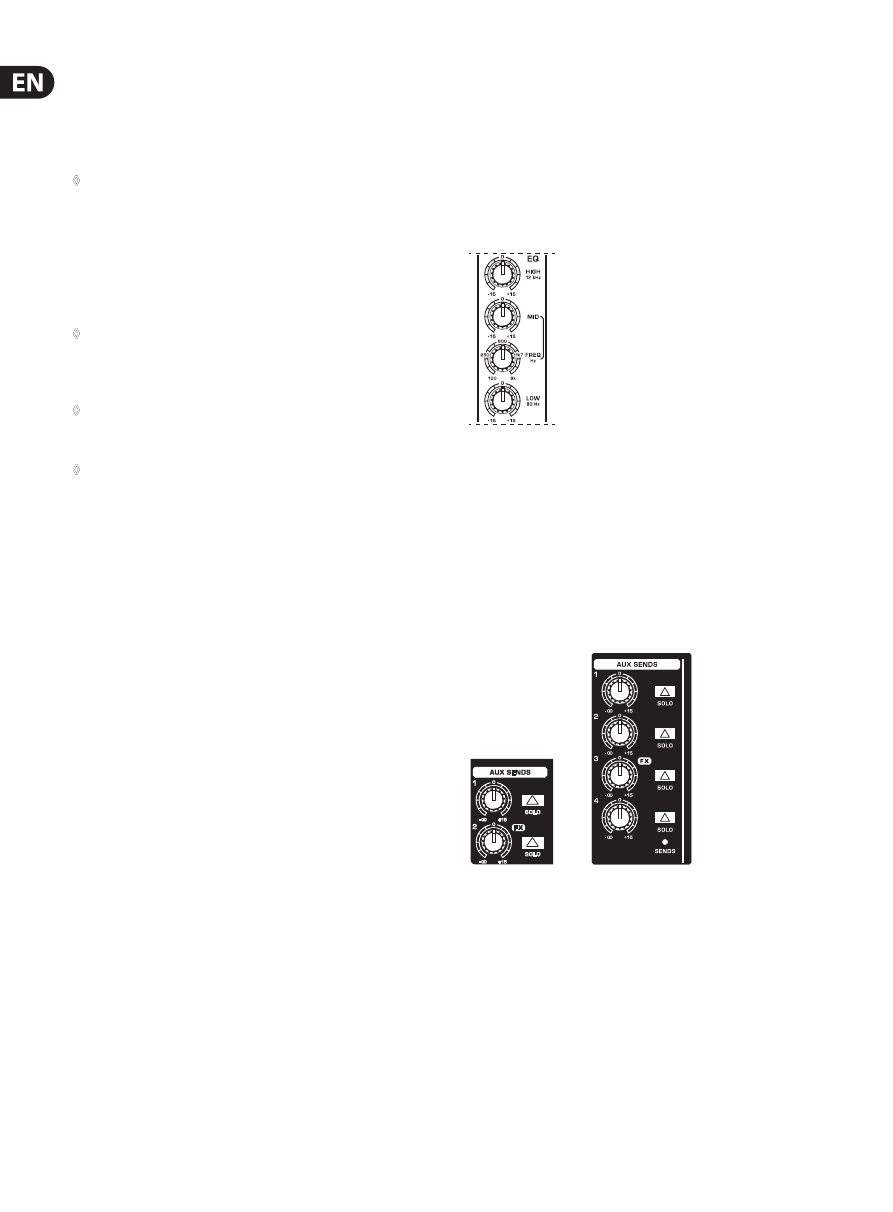
6
XENYX X2442USB/X2222USB/X1832USB/X1622USB User Manual
MIC
Each mono input channel offers a balanced microphone input via the XLR
connector and also features switchable +48 V phantom power supply for
condenser microphones. The XENYX preamps provide undistorted and noise-free
gain as is typically known only from costly outboard preamps.
◊
Please mute your monitor system before you switch on phantom
power. Otherwise potentially damaging thumps will be sent to
your speakers. Please also note the instructions in chapter 5.5
“Voltage supply, phantom power and fuse”.
LINE IN
Each mono input also has a balanced line input on a ¼" jack. You can also connect
unbalanced devices using mono jacks to these inputs.
◊
Please remember that you can use either the microphone input or the
line input of a channel, but not both at the same time!
INSERT
◊
Insert points enable the processing of a signal with dynamic processors
or equalizers. They are sourced pre-fader, pre-EQ and pre-aux send.
Detailed information on using insert points can be found in chapter 5.3.
◊
Unlike the X2442USB, the X1622USB, X1832USB and X2222USB have
their insert points located on the rear of the console.
GAIN
Use the
GAIN
control to adjust the input gain. This control should always be
turned fully counter-clockwise whenever you connect or disconnect a signal
source to one of the inputs.
The scale has 2 different value ranges: the first value range (
+10
to
+60 dB
)
refers to the MIC input and shows the
amplification
for the signals fed in there.
The second value range (
+10
to
-40 dB
) refers to the line input and shows its
sensitivity
. The settings for equipment with st andard line-level signals (-10 dBV
or +4 dBu) look like this: While the GAIN control is turned all the way down,
connect your equipment. Set the GAIN control to the external devices’ standard
output level. If that unit has an output signal level display, it should show 0 dB
during signal peaks. For +4 dBu, turn up GAIN slightly, for -10 dBV a bit more.
Fine-tuning of a signal being fed in is done using the level meter. To route the
channel signal to the level meter, you have to press the SOLO switch and set the
MODE switch in the main section to PFL (LEVEL SET).
Using the GAIN control, drive the signal to the 0-dB mark. This way you have
a vast amount of drive headroom for use with very dynamic signals. The CLIP
display should light up only rarely, preferably never. While fine-tuning,
the equalizer should be set to neutral.
LOW CUT
Additionally, the mono channels of the mixing consoles have a high-slope
LOW CUT
filter for eliminating unwanted, low-frequency signal components
(75 Hz, 18 dB/octave).
COMPRESSOR
Each mono channel features a built-in compressor which lowers the dynamic
range of the signal and increases its perceived loudness. The loud peaks are
squashed down and the quiet sections are boosted.
Turn the COMP knob clockwise to add more compression effect. The adjacent LED
with light when the effect is engaged.
2.1.2 Equalizer
All mono input channels have a 3-band equalizer with semi-parametric mid
bands. All bands provide boost or cut of up to15 dB. In the central position,
the equalizer is off (flat).
The circuitry of the British EQs is based on the technology used in the best-known
top-of-the-line consoles and providing a warm sound without any unwanted
side effects. The result are extremely musical equalizers which, unlike simple
equalizers, cause no side effects such as phase shifting or bandwidth limitation,
even with extreme gain settings of ±15 dB.
All Models
Fig. 2.2: Equalizer of the input channels
The upper (HIGH) and the lower (LOW) bands are shelving filters that increase
or decrease all frequencies above or below their cut-off frequency. The cut-off
frequencies of the upper and lower bands are 12 kHz and 80 Hz respectively.
For the mid range, the console features a semi-parametric equalizer with a
filter quality (Q) of 1 octave, tunable from 100 Hz to 8 kHz. Use the MID control
to set the amount of boost or cut, and the FREQ control to determine the
central frequency.
2.1.3 Monitor and effects busses (Aux Sends)
X1622USB
X2442USB
Fig. 2.3: Aux Send control MON and FX in the channel strips
Monitor and effects busses (AUX sends) source their signals via a control from
one or more channels and sum these signals to a so-called bus. This bus signal
is sent to an aux send connector (for monitoring applications: MON OUT) and
then routed, for example, to an active monitor speaker or external effects device.
In the latter case, the effects return can then be brought back into the console via
the aux return connectors.
All monitor and effects busses are mono, are tapped into post EQ and offer
amplification of up to +15 dB.






























